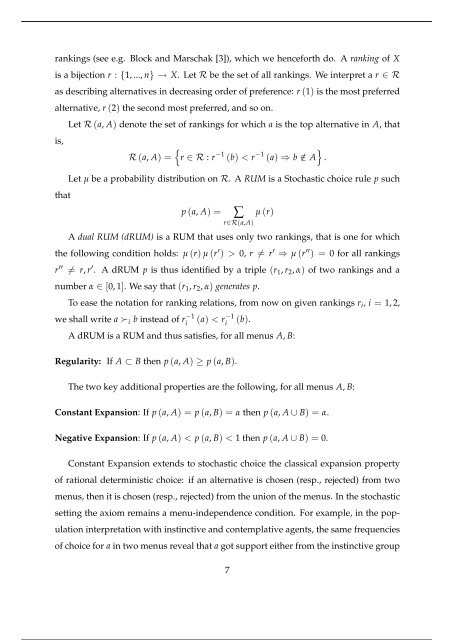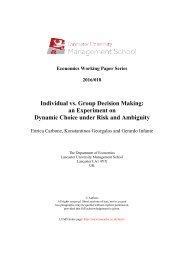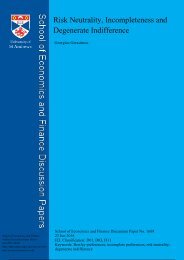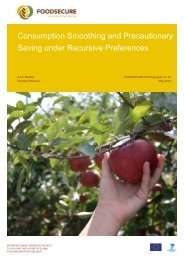Dual Random Utility Maximisation
n?u=RePEc:san:wpecon:1605&r=upt
n?u=RePEc:san:wpecon:1605&r=upt
Create successful ePaper yourself
Turn your PDF publications into a flip-book with our unique Google optimized e-Paper software.
ankings (see e.g. Block and Marschak [3]), which we henceforth do. A ranking of X<br />
is a bijection r : {1, ..., n} → X. Let R be the set of all rankings. We interpret a r ∈ R<br />
as describing alternatives in decreasing order of preference: r (1) is the most preferred<br />
alternative, r (2) the second most preferred, and so on.<br />
Let R (a, A) denote the set of rankings for which a is the top alternative in A, that<br />
is,<br />
R (a, A) =<br />
{<br />
}<br />
r ∈ R : r −1 (b) < r −1 (a) ⇒ b /∈ A .<br />
that<br />
Let µ be a probability distribution on R. A RUM is a Stochastic choice rule p such<br />
p (a, A) =<br />
∑ µ (r)<br />
r∈R(a,A)<br />
A dual RUM (dRUM) is a RUM that uses only two rankings, that is one for which<br />
the following condition holds: µ (r) µ (r ′ ) > 0, r ̸= r ′ ⇒ µ (r ′′ ) = 0 for all rankings<br />
r ′′ ̸= r, r ′ . A dRUM p is thus identified by a triple (r 1 , r 2 , α) of two rankings and a<br />
number α ∈ [0, 1]. We say that (r 1 , r 2 , α) generates p.<br />
To ease the notation for ranking relations, from now on given rankings r i , i = 1, 2,<br />
we shall write a ≻ i b instead of r −1<br />
i<br />
(a) < r −1<br />
i<br />
(b).<br />
A dRUM is a RUM and thus satisfies, for all menus A, B:<br />
Regularity: If A ⊂ B then p (a, A) ≥ p (a, B).<br />
The two key additional properties are the following, for all menus A, B:<br />
Constant Expansion: If p (a, A) = p (a, B) = α then p (a, A ∪ B) = α.<br />
Negative Expansion: If p (a, A) < p (a, B) < 1 then p (a, A ∪ B) = 0.<br />
Constant Expansion extends to stochastic choice the classical expansion property<br />
of rational deterministic choice: if an alternative is chosen (resp., rejected) from two<br />
menus, then it is chosen (resp., rejected) from the union of the menus. In the stochastic<br />
setting the axiom remains a menu-independence condition. For example, in the population<br />
interpretation with instinctive and contemplative agents, the same frequencies<br />
of choice for a in two menus reveal that a got support either from the instinctive group<br />
7






